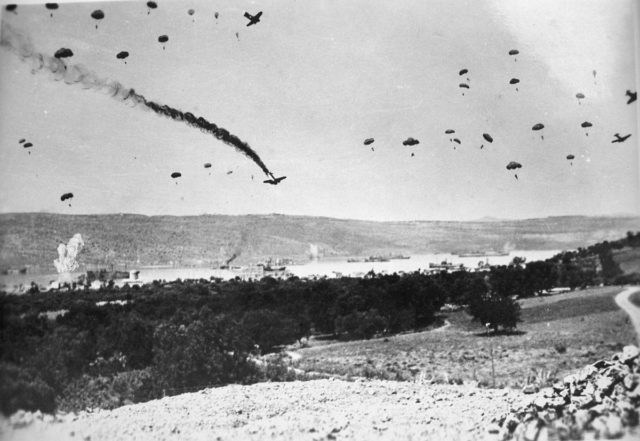Realizing he could be shot by Nazi guards at any moment, RAF doctor Tom Cullen’s heart raced as he scrambled over the 8-foot high barbed wire fence at the prisoner of war camp where he was being held.
The guards had been preoccupied by the phony riot his fellow PoWs manufactured to aid the escape bid in Nazi-occupied Poland as the Second World War raged in Europe.
After getting over the fence, Tom and another daring British serviceman made their way across Poland, and surreptitiously moved between safe houses before hiding themselves away on a ship to neutral Sweden then finally being airlifted home to Britain.
Cullen, now 100, knows how to keep a secret. Only recently did he reveal, 70 years later, details about the escape from Stalag XXA close to Toruń in northern Poland.
The great-grandfather, one of Britain’s last surviving Nazi PoW escapees, said it became known in the camp that if people could escape the camp, there would be Poles that would assist getting them out of the country.
He was asked by another prisoner to escape together, and Cullen decided to “give it a go.”
They probably would have been shot on sight if they had been spotted, he added.
The squadron leader was captured by German paratroopers during ferocious fighting in 1941 at Maleme, Crete.
He was quickly told to try and treat more than 1,000 wounded men, although he had minimal medical supplies.
There was no way out. He had to get on with it. Even if you had not done the operations before, you had to treat the wounds as best you could.
Cullen received the MBE military honor for his attempts to treat soldiers. The citation lauded his bravery and devotion to duty and valor of the highest order.
Cullen, who served with 33 Squadron, said they were aware the invasion was coming but did not know what it would be like. They all thought they would be killed. The entire campaign in Crete was a complete mess.

Despite his diminishing memory, the war veteran clearly recalls the miserable conditions in the camp, which he described as his very own Colditz.
It appeared as an old fort surrounded by a moat. It was partly below ground, he explained. While locked up, Tom wrote home once per week to his parents in Kelvedon, Essex, asking for the latest news about the pet dogs, local gossip, and the family vegetable patch.
After the Battle of Stalingrad, which finished in 1943, Tom and Army officer John Grieg devised an escape plan with Red Cross workers.
There were two aspects to the plan. If you escape from your camp that’s one aspect, but having escaped how do you return to your country?
His view was that if you did not have a plan how to get out the country, why would you escape?
Cullen had spent two-and-a-half years in the Nazi camp prior to the escape under cover of night on February 29, at the age of 27.
Following weeks of planning, the pair donned Polish clothes other prisoners had sewn for them so they would fit in with the community once outside the fence.
The Polish resistance also helped in the escape. After the mock riot had started, Cullen and Tom crossed the frozen moat, toting a ladder so they could scale the barbed wire barrier.
The moat was frozen over, and they took the ladder with them, he said. It had a rope and they were able to pull it back. It made a noise when it fell, but thankfully the guards were too distracted to notice. Then they had to go past the guardhouse into a field. They hid some shrubbery and waited for a truck to travel up the road, while they waited to see what would occur next.
The lorry arrived at the predetermined point, and the resistance fighters took the Brits over 100 miles to the port down Gdynia, near Gdansk, where they spent a week switching between safehouses.
Cullen said they stayed on a farm while they waited for the right ship for transporting them, and the resistance took them to the city. A man accompanied them and once on a bus they sat near the back and tried not to converse with anyone.
They followed 50 yards behind him on the docks, they were given a shovel each and told they were going to move coal on the ship.
The men hid in the hold for 36 hours in pitch darkness without sanitation facilities and then revealed themselves to the crew. Luckily, the crew did not betray them to the captain.
The boat arrived three days later in Malmo in neutral Sweden, where Cullen and Greig were handed to the police then came under the care of the British ambassador.
Almost three weeks after the escape from the camp, they were flown to Scotland and then returned to their families. Cullen did not meet Grieg again.
Cullen served the remainder of the war at RAF Halton in Bucks where he met his future wife, Catherine Mary Lockerbie. Together, they had four children, 11 grandchildren, and 11 great-grandchildren.
After the war, he had a career as a surgeon before living in Colchester, Essex, where he still resides. His wife died in 2006.
Cullen’s son, Tom, said they only learned about the daring escape of 1,000 miles only in the last 20 years, Mirror reported.
He adds, when you ask his father about it, it is like talking about a lengthy, boring weekend in Poland instead of escaping from a PoW camp.
